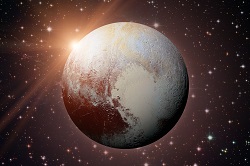Calibrating exoplanetary atmospheres using benchmark brown dwarfs
Scientists are constantly trying to understand how planets are made, a task that requires them to observe exoplanets and measure their composition – which is easier said than done. Although over the last few years there have been a number of new instruments built on telescopes capable of taking direct images of planets and stars, the cloudy atmospheres of their targets make interpreting these observations tricky. Through the EU-funded CALEXOPLAN project, Marie Curie Fellow Dr. Ben Burningham has developed a new code that allows for the interrogation of this data and the measuring of composition, temperature profile, surface gravity, and cloud properties in cases where obscuring clouds are present. The tool has been tested on self-luminous brown dwarfs, with hopes of transitioning to exoplanets in the near future. ‘Because we’re dealing with cases where clouds are present and blocking the light from deeper in the atmosphere, it’s crucial to calibrate and make sure our tools are working the way we expect,’ explains Dr. Burningham. Testing model Brown dwarfs are similar to giant planets, but are formed on their own rather than from discs around stars, which makes them easier to observe in many ways. ‘They don’t have the light of a bright star next to them, so we can get better data and start out with a better idea of what they’re made of,’ says Dr. Burningham. ‘We can use them as benchmarks, and right now we’re at the stage of using them to calibrate our new remote sensing tool.’ ‘No one has done this in these kinds of objects where there are clouds, so the CALEXOPLAN project is running the first field tests on brown dwarfs where we have different types of clouds present,’ adds Burningham. Dr. Burningham’s tool uses a technique called atmospheric retrieval, a technique common for people who study planets within our solar system, but not for those studying brown dwarfs and self-luminous giant planets. ‘It’s taking a tool that is used in solar system work and rewriting it for self-luminous planets outside of the solar system, young planets that shine themselves rather than being visible through reflected star light,’ he says. End goal In the immediate future, results will not be tangible for the general public, but this ability to observe brown dwarfs, even with cloud coverage, is an important technique for future studies of how planets are made and their habitability. ‘For example, we may find that our understanding of the interaction of the atmospheric gases with light is not as good as we thought it was, and this feeds into a bigger picture for those who want to study biological signatures in the future,’ concludes Dr. Burningham. ‘It’s curiosity-driven science rather than industrial application, but these are questions that speak to our origins and that humans have been trying to answer for a long time.’ For more information please see: CORDIS project page
Countries
United Kingdom



